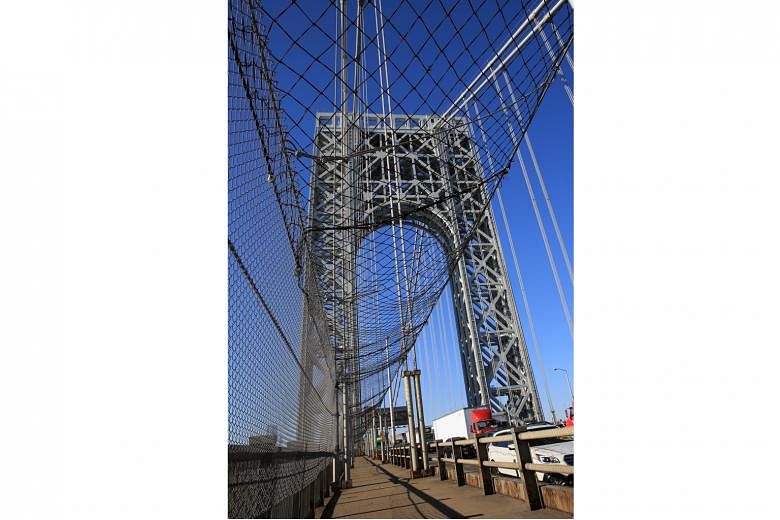NEW YORK • Captain Emilio Gonzalez read, aloud, some statistics for last year. He repeated one: "Sixty-eight saves."
At the Port Authority Police Department, he is the commanding officer responsible for the George Washington Bridge - one of the world's busiest - in New York.
The figure he repeated was for suicide attempts that were blocked by his officers. An attempt is thwarted once nearly every five days.
Fifteen people jumped to their deaths there last year.
Now, Mr Gonzalez has a new tool designed to prevent such incidents - a 3.4m-high fence connected to netting that forms a canopy over a pathway beyond the traffic lanes.
Until now, the only barrier along the pathway was a barricade-high railing. The Port Authority has officers who monitor cameras trained on the pathway and can dispatch staff, even a fully equipped emergency unit, if they see someone among the runners and cyclists who arouses their suspicions.
Until now, that meant someone who lingered too close to the railing for too long.
The chain-link fence is too tall to scale quickly and getting around the canopy would require unusual strength and agility.
The Port Authority installed the fence and netting last September on the pathway along the south side of the bridge, but these design add-ons are only temporary.
A permanent fence will be installed later, after the completion of a permanent fence on the north side as part of a Restoring The George rehabilitation programme for the 86-year-old bridge.
"I don't think that's something anyone thinks about when they design a bridge," Mr Gonzalez said.
"What was there was what was designed when the bridge was built, the height (of the railing) on most bridges. Nothing unusual."
The work on the north side began when the temporary fence on the south side was completed last month, eight months after work began on a "suicide deterrent net" under the Golden Gate Bridge in San Francisco. The net, made of stainless steel, will reach out 6m from the bridge.
Of the temporary fence on the upper level of the George Washington Bridge, Mr Gonzalez said: "It's a very good feat of engineering because if you have a person who's hellbent on jumping, it's going to be very difficult to climb the device and get over."
And by the time "that happens, we'll pick up on the CCTV cameras. We'll intervene and more than likely save the person".
Experts said barriers on bridges are effective tools for preventing suicides. A 2015 analysis published in the journal The Lancet Psychiatry averaged 18 suicide studies and concluded that placing safety nets under known "hot spots" reduced death rates.
The study found that the death rate - an average of 5.8 a year before such nets were installed - dipped to an average of 2.4, a decline of 58 per cent.
Dr Jill Harkavy-Friedman, vice-president for research of the American Foundation for Suicide Prevention, said putting a barrier on one bridge did not normally lead to higher suicide rates on nearby bridges.
On the George Washington Bridge, signs on the pathway urge people to seek help and there are call boxes that dial a hotline.
Besides the 68 "saves" on the George Washington Bridge, another 37 suicide attempts that were thwarted were counted as "investigations", meaning that the Port Authority police received word that someone who was suicidal was going to the bridge.
Mr Gonzalez said police tracked them down, usually before they were anywhere near the bridge, using technology that picks up signals from cellphones.
NYTIMES

